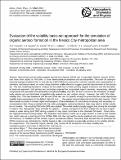Evaluation of the volatility basis-set approach for the simulation of organic aerosol formation in the Mexico City metropolitan area
Author(s)
Tsimpidi, A. P.; Karydis, V. A.; Zavala-Perez, Miguel Angel; Lei, Wenfang; Molina, Luisa Tan; Ulbrich, I. M.; Jimenez, J. L.; Pandis, S. N.; ... Show more Show less
DownloadTsimpidi-2010-Evaluation of the volatility basis-set approach for the simulation.pdf (1.544Mb)
PUBLISHER_CC
Publisher with Creative Commons License
Creative Commons Attribution
Terms of use
Metadata
Show full item recordAbstract
New primary and secondary organic aerosol modules have been added to PMCAMx, a three dimensional chemical transport model (CTM), for use with the SAPRC99 chemistry mechanism based on recent smog chamber studies. The new modeling framework is based on the volatility basis-set approach: both primary and secondary organic components are assumed to be semivolatile and photochemically reactive and are distributed in logarithmically spaced volatility bins. This new framework with the use of the new volatility basis parameters for low-NOx [low - NO subscript x] and high-NOx [high - NO subscript x] conditions tends to predict 4–6 times higher anthropogenic SOA concentrations than those predicted with older generation of models. The resulting PMCAMx-2008 was applied in Mexico City Metropolitan Area (MCMA) for approximately a week during April of 2003. The emission inventory, which uses as starting point the MCMA 2004 official inventory, is modified and the primary organic aerosol (POA) emissions are distributed by volatility based on dilution experiments. The predicted organic aerosol (OA) concentrations peak in the center of Mexico City reaching values above 40 μg [mu g] m−3 [m superscript -3]. The model predictions are compared with Aerosol Mass Spectrometry (AMS) observations and their Positive Matrix Factorization (PMF) analysis. The model reproduces both Hydrocarbon-like Organic Aerosol (HOA) and Oxygenated Organic Aerosol (OOA) concentrations and diurnal profiles. The small OA underprediction during the rush hour periods and overprediction in the afternoon suggest potential improvements to the description of fresh primary organic emissions and the formation of the oxygenated organic aerosols respectively, although they may also be due to errors in the simulation of dispersion and vertical mixing. However, the AMS OOA data are not specific enough to prove that the model reproduces the organic aerosol observations for the right reasons. Other combinations of contributions of primary, aged primary, and secondary organic aerosol production rates may lead to similar results. The model results suggest strongly that during the simulated period transport of OA from outside the city was a significant contributor to the observed OA levels. Future simulations should use a larger domain in order to test whether the regional OA can be predicted with current SOA parameterizations. Sensitivity tests indicate that the predicted OA concentration is especially sensitive to the volatility distribution of the emissions in the lower volatility bins.
Date issued
2010-01Department
Massachusetts Institute of Technology. Department of Earth, Atmospheric, and Planetary SciencesJournal
Atmospheric Chemistry and Physics
Publisher
European Geosciences Union / Copernicus
Citation
Tsimpidi, A. P. et al. “Evaluation of the Volatility Basis-set Approach for the Simulation of Organic Aerosol Formation in the Mexico City Metropolitan Area.” Atmospheric Chemistry and Physics Discussions 9.3 (2009) : 13693-13737. © Author(s) 2009
Version: Final published version
ISSN
1680-7324
1680-7316